
Every year on the second Monday of October, communities across the United States and beyond celebrate Indigenous Peoples’ Day. This day serves as a powerful reminder of the rich history, culture, and contributions of Indigenous peoples, while also acknowledging the historical injustices they have faced.
Indigenous Peoples’ Day was established as an alternative to Columbus Day, which has been celebrated in the U.S. since the late 19th century. While Columbus Day honors Christopher Columbus’s arrival in the Americas in 1492, it often overlooks the impact of European colonization on Indigenous communities. For many Indigenous peoples, this period marked the beginning of centuries of displacement, violence, and cultural erasure.
In the 1970s, activists began advocating for a day that recognized Indigenous histories and cultures instead of glorifying colonialism. In 1990, the first Indigenous Peoples Day was declared in Berkeley, California. Since then, more than 130 cities and several states have adopted the day, recognizing the need for a more accurate representation of history.
Celebrating Culture and Resilience
Indigenous Peoples Day is not just about remembrance; it’s a celebration of Indigenous cultures and their ongoing resilience. Events typically include:
- Cultural Festivals: Many communities host festivals that feature traditional music, dance, art, and storytelling. These events offer a platform for Indigenous artists and performers to share their heritage.
- Educational Activities: Workshops, lectures, and panel discussions provide opportunities for education about Indigenous history, rights, and contemporary issues. Schools often participate by incorporating Indigenous perspectives into their curricula.
- Community Engagement: Many local organizations and tribal nations encourage community members to engage with Indigenous leaders and participate in discussions about land, sovereignty, and cultural preservation.
Acknowledging the Past and Looking Forward
Indigenous Peoples Day also serves as a call to action. It emphasizes the importance of recognizing the ongoing struggles faced by Indigenous communities, including land rights, environmental justice, and cultural preservation. Many activists advocate for the inclusion of Indigenous perspectives in decision-making processes, particularly regarding natural resource management and education.
How to Get Involved
If you’re interested in participating in Indigenous Peoples Day, here are some ways to engage:
- Attend Local Events: Look for celebrations, festivals, and educational programs in your area.
- Support Indigenous Artists: Seek out Indigenous artists, authors, and businesses to support their work and amplify their voices.
- Educate Yourself and Others: Read books, watch documentaries, and engage with resources that highlight Indigenous histories and cultures.
- Advocate for Change: Support policies and initiatives that promote Indigenous rights and sovereignty. Engage with local Indigenous communities to learn how you can help.
Indigenous Peoples’ Day is more than just an alternative to Columbus Day; it’s a vital opportunity to recognize and honor the rich tapestry of Indigenous cultures, histories, and contributions. As we celebrate, let us also reflect on the ongoing journey toward reconciliation and justice, acknowledging that understanding and respect for Indigenous peoples are crucial for building a more equitable future for all.



